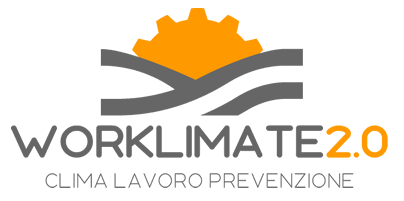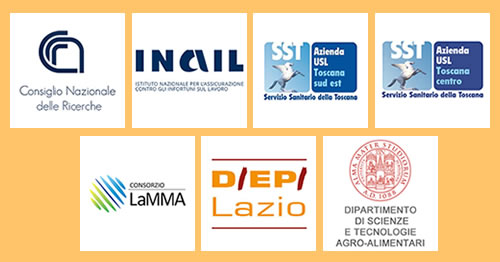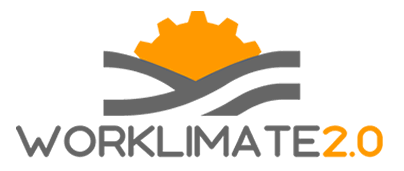
PROTOTYPE HEAT STRESS FORECASTING SYSTEM FOR THE INITIAL SCREENING OF RISKS AMONG OUTDOOR WORKERS
Experimental activity for use by workers, employers occupational safety and management professionals.
Heat risk forecast maps for workers exposed to different occupational scenarios
Heat risk forecasts based on the “anti-heat” ordinance in force in some Italian regions
Forecasts of the areas where exceeding the daily temperature threshold of 35°C is possible
Heat risk forecast maps for workers exposed
to different occupational scenarios
National heat risk forecast maps, based on the MOLOCH meteorological model (about 2 km of spatial resolution) and valid for workers not acclimated to the heat and exposed to different occupational scenarios, developed on the basis of an indicator used in the occupational sector and selected within the project.
Experimental and automatic (uncontrolled) forecasts based on meteorological models are affected by intrinsic uncertainty and can be significantly different from real conditions. Forecasts should therefore be considered as a decision support tool to integrate existing tools and weather-climate observation accomplished directly in the workplace.
Maps show the heat risk forecast for up to three days, for four moments of the day corresponding to 8, 12, 16 and 20.
THE INFORMATION RELATES TO A HEALTHY WORKER, NOT ACCLIMATISED TO HEAT, EXPOSED TO DIRECT SUN OR SHADE AND ENGAGED IN INTENSE OR MODERATE OUTDOOR PHYSICAL ACTIVITY.
The average values of metabolic energy for each work activity have been derived from the UNI EN ISO 8996 standard.
A more detailed discussion can be found in the following report: Report_O4_A1.pdf.
The examples provided are general guidelines, and it remains well established that a precise assessment can only be carried out in the specific workplace and based on the specific working conditions.
Moderate physical activity includes:
- Upper limb activities (hammering nails, filing)
- Driving off-road trucks, tractors or construction machinery
- Working with the upper body (pneumatic hammer work, tractor assembly, plastering, intermittent handling of moderately heavy material, weeding, hoeing, picking fruit or vegetables)
- Pushing or pulling light carts or wheelbarrows
- Walking at a moderate speed (3.5 and 5.5 km/h)
- Laying bricks
- Assembling vehicles
Intense physical activity includes:
- Physically intensive upper body activity; carrying heavy material
- Work requiring the use of axes or shovels for shoveling or digging at an intense pace
- Working with a hammer
- Sawing, planing or chiselling hard wood
- Hand mowing, digging
- Walking at a speed between 5.5 and 7.0 km/h
- Pushing or pulling wheelbarrows and barrows with heavy loads
- Arranging concrete blocks
- Repeatedly climbing steps or ladders
Find a forecasts
This forecast is intended as a decision support tool and needs to be integrated by the direct microclimatic onsite monitoring of the workplace.
Heat risk forecasts based on the “anti-heat” ordinance
in force in some Italian regions
Forecasts of heat risk based on some regional ordinances which, on the basis of the MOLOCH meteorological model (about 2 km spatial resolution), indicate the ban on carrying out work in the agricultural sector between 12:30 and 16:00, limited to days in which the heat risk is “HIGH” (it is referred to a healthy worker, without individual conditions of thermal susceptibility, not acclimatized to the heat, exposed to the sun at 12:00 and engaged in intense physical activity).
Experimental and automatic (uncontrolled) forecasts based on meteorological models are affected by intrinsic uncertainty and can be significantly different from real conditions. Forecasts should therefore be considered as a decision support tool to integrate existing tools and weather-climate observation accomplished directly in the workplace.
INDICATE THE LOCATION IN WHICH THE 3-DAY FORECAST OF THE HEAT RISK FOR A HEALTHY WORKER (WITHOUT INDIVIDUAL THERMAL SUSCEPTIBILITY CONDITIONS), NOT ACCLIMATED TO THE HEAT, EXPOSED TO THE SUN AT 12:00 AND ENGAGED IN INTENSIVE PHYSICAL ACTIVITY.
FORECASTS OF AREAS WHERE EXCEEDING
THE DAILY TEMPERATURE THRESHOLD OF 35°C IS POSSIBLE
Experimental and automated (uncontrolled) forecasts based on meteorological models are affected by intrinsic uncertainty and can be significantly different from real conditions. Forecasts should therefore be considered as a decision support tool to integrate existing tools and procedures and weather-climate observation carried out directly in the workplace.
National forecast maps of the possible exceeding of the air temperature threshold of 35 °C
based on the MOLOCH meteorological model (about 2 km spatial resolution).
partners


